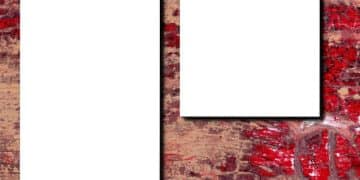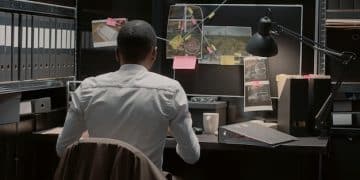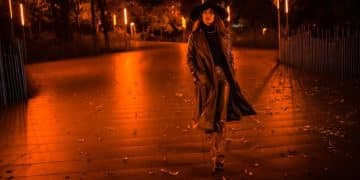The Editor’s Role: How Cutting and Pacing Define a Movie
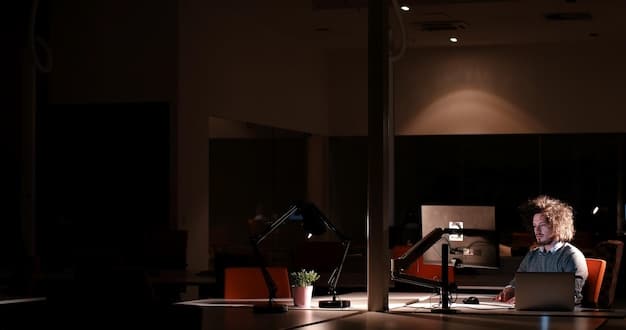
The role of the editor is pivotal in shaping a movie’s narrative, influencing its pacing and emotional impact through strategic cutting and arrangement of scenes.
Ever wondered how a movie grips you from start to finish? It’s not just the actors or the director; the unsung hero is the editor. They masterfully sculpt hours of footage into a compelling story. The role of the editor: How cutting and pacing shape a movie is crucial, and we’re about to dive into it.
The Editor as Storyteller
The editor is more than just a technician. They’re storytellers who use cutting and pacing to craft a narrative that resonates with the audience. They transform raw footage into a cohesive and emotionally engaging experience.
Shaping the Narrative
Editors decide the sequence of events, the duration of each shot, and the overall rhythm of the film. These choices impact how the story unfolds and how the audience perceives the characters and events.
Creating Emotional Impact
By carefully selecting and arranging shots, editors can evoke specific emotions in the viewer. A well-placed cut can heighten tension, create suspense, or elicit a sense of joy or sadness.
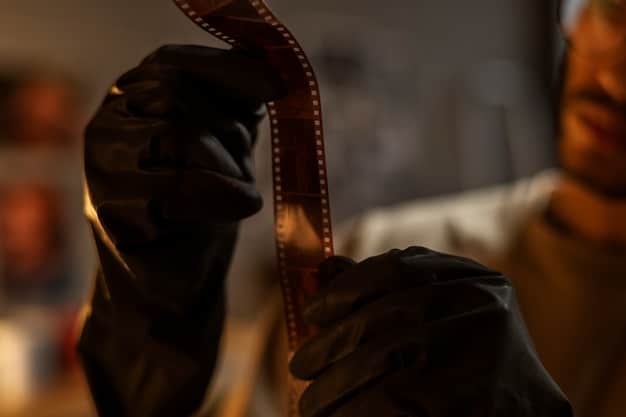
The editor’s influence extends beyond plot points. They influence atmosphere, character development, and the overall message of the film. Cutting and pacing are their primary tools for shaping the audience’s experience.
Key elements of a storyteller editor:
- Selecting the best takes from hours of footage
- Arranging scenes to build suspense and emotional engagement
- Adjusting the rhythm to control the audience’s experience
Ultimately, the editor shapes a movie into a cohesive and compelling narrative. Their skill in cutting and pacing transforms raw footage into an immersive story.
Understanding Cutting Techniques
Cutting techniques are the foundation of editing. Editors use a variety of cuts to transition between shots, each serving a different purpose and creating a unique effect. These techniques are essential for controlling the narrative flow.
Types of Cuts
There are several types of cuts, including straight cuts, jump cuts, crossfades, and dissolves. Each type creates a different transition effect, influencing the pacing and mood of the scene.
Rhythmic Cutting
Rhythmic cutting involves adjusting the length of shots to create a specific rhythm or tempo. This technique can be used to heighten tension, create excitement, or establish a sense of calm.
Different cutting techniques include:
- Straight cuts for seamless transitions
- Jump cuts for jarring, disorienting effects
- Crossfades for smooth, gradual changes between scenes
- Dissolves for blending shots and creating a sense of continuity
Cutting techniques can also:
- Use fades to slowly transition out of a frame
- Use wipes to transition into a scene with a line
- Use match cuts that connect similar elements from one scene to another
Effective cutting is essential for guiding the viewer through the story and maintaining their engagement. Editors use these techniques to control pacing, create emotional impact, and enhance the overall viewing experience.
The Importance of Pacing
Pacing refers to the speed at which a story unfolds. A well-paced movie keeps the audience engaged without feeling rushed or dragging on. Editors control pacing by adjusting the length of scenes and shots, using various cutting techniques to maintain interest.
Creating Tension and Release
Editors can manipulate pacing to create tension and release. Fast-paced sequences with short shots can heighten tension, while slow-paced sequences with long shots can provide a sense of calm or anticipation.
Maintaining Audience Engagement
Varied pacing keeps the audience engaged by preventing monotony. A mix of fast and slow scenes maintains interest and ensures the viewer remains invested in the story.
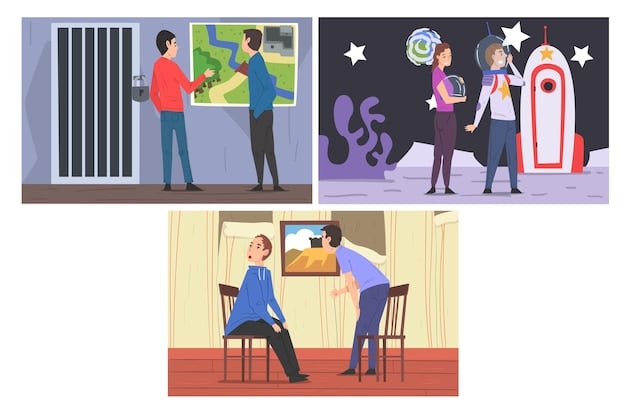
Poor pacing can lead to audience disengagement and boredom. A movie that is too slow can lose the viewer’s attention, while a movie that is too fast can feel overwhelming and confusing.
When constructing the pacing of a movie, editors often utilize:
- Fast-paced action sequences to quicken the plot and raise the stakes
- Slower dramatic or emotional scenes to let the narrative breathe
- Quick cuts to compress time or speed up an event
Skilled editors use pacing to create a balanced and engaging viewing experience. They understand how to manipulate time and rhythm to keep the audience invested in the story from beginning to end.
Collaboration Between Director and Editor
The relationship between the director and the editor is critical to the success of a film. They work closely together, combining their creative visions to shape the final product. Effective communication and mutual respect are essential for a productive collaboration.
Sharing a Vision
The director and editor must share a common vision for the film. The director provides guidance and feedback, while the editor offers their expertise in cutting, pacing, and storytelling.
Finding the Best Cut
The editing process often involves experimentation and compromise. The director and editor work together to find the best way to tell the story, sometimes making difficult decisions about what to cut or change.
Successful collaboration results in:
- Clear and open communication between the director and editor
- The editor’s creative input into the narrative
- An editing process that leads to a polished finished product
The collaboration and relationship between the director and editor includes.
- Discussing the overarching vision of the film
- Analyzing each scene’s purpose and emotional tone
- Offering feedback on each others suggestions
In conclusion, the partnership between the director and editor is a symbiotic relationship that enhances the quality and impact of the film. Their combined expertise ensures that the story is told in the most compelling and effective way possible.
Examples of Effective Editing in Film
Many films showcase the power of editing. These examples highlight how cutting and pacing can enhance storytelling, create emotional impact, and elevate the overall viewing experience. Here are a few notable examples.
“Psycho” (1960)
Alfred Hitchcock’s “Psycho” features a famous shower scene that is a masterclass in editing. The rapid cuts and jarring sound effects create a sense of terror and suspense, making it one of the most memorable scenes in cinematic history.
“The Social Network” (2010)
David Fincher’s “The Social Network” employs fast-paced cutting and dynamic transitions to capture the energy and excitement of the early days of Facebook. The editing enhances the film’s sense of urgency and ambition.
Other examples of impactful editing can be seen in:
- “Goodfellas” (1990) with its use of long takes and energetic montages
- “Arrival” (2016) with its non-linear timelines
- “Mad Max: Fury Road” (2015) with its relentless action
Great editing can enhance the story and elevate the filmmaking.
- “Pulp Fiction” (1994) a perfect example of nonlinear storytelling
- “Baby Driver” (2017) showcasing visuals matched with the music in the scenes
These films demonstrate the transformative power of editing, proving how cutting and pacing can elevate a movie from good to great. They serve as inspiration for aspiring editors and filmmakers alike.
The Future of Editing Technology
Editing technology is constantly evolving. New tools and techniques are emerging, offering editors greater creative control and efficiency. These advancements are transforming the industry and opening up new possibilities for storytelling.
Non-Linear Editing Systems
Modern editing software allows editors to work non-linearly, meaning they can access and modify any part of the film at any time. This flexibility streamlines the editing process and empowers editors to experiment with different ideas.
Artificial Intelligence
AI is beginning to play a role in editing. AI-powered tools can assist with tasks such as scene selection, color correction, and sound mixing, potentially freeing up editors to focus on more creative aspects of their work.
Other cutting-edge technologies like VR and 3D movies are also developing.
- AI-powered auto-cutting
- Advanced color correction
- Improved sound design
Technological advances are making editing more efficient and accessible, while also creating new creative opportunities.
- Greater opportunities for editors
- New software for more complex editing
The future of editing technology promises to be exciting, with potential to revolutionize movie production. As technology continues to evolve, editors will have access to ever-more powerful tools, enabling them to push the boundaries of storytelling.
| Key Aspect | Brief Description |
|---|---|
| 🎬 Editing’s Role | Shapes narrative, emotion, and pacing in movies. |
| ✂️ Cutting Techniques | Includes straight cuts, jump cuts, crossfades, and dissolves. |
| ⏱️ Importance of Pacing | Controls rhythm, tension, and audience engagement. |
| 🤝 Collaboration | Requires communication between director and editor. |
FAQ
▼
The editor assembles raw footage into a cohesive and compelling narrative. They make critical decisions about scene selection, pacing, and overall storytelling. They are also in charge of creating a lasting emotional impact.
▼
Editors control pacing through the length of shots and scenes. They can create a fast-paced, exciting feel or a slow, deliberate mood. Pacing is essential for maintaining audience engagement and building tension.
▼
Common techniques include straight cuts, jump cuts, crossfades, and dissolves. Straight cuts provide seamless transitions while jump cuts create jarring effects. Crossfades gently blend scenes together and improve transition.
▼
The director and editor work together to shape the film’s vision. Open communication and mutual respect ensures a cohesive, impactful final product. They rely on each other to bring the best movie to life.
▼
Technology offers non-linear editing and AI-assisted tools. Non-linear editing provides flexibility to access and modify footage easily. Also, AI helps with many editing tasks improving movie production and quality.
Conclusion
In conclusion, the editor’s contribution to a film is indispensable. Through a mastery of cutting and pacing, a strong sense of storytelling, and collaborative engagement with the director, the editor transforms raw footage into a polished cinematic experience that captivates and engages audiences.
